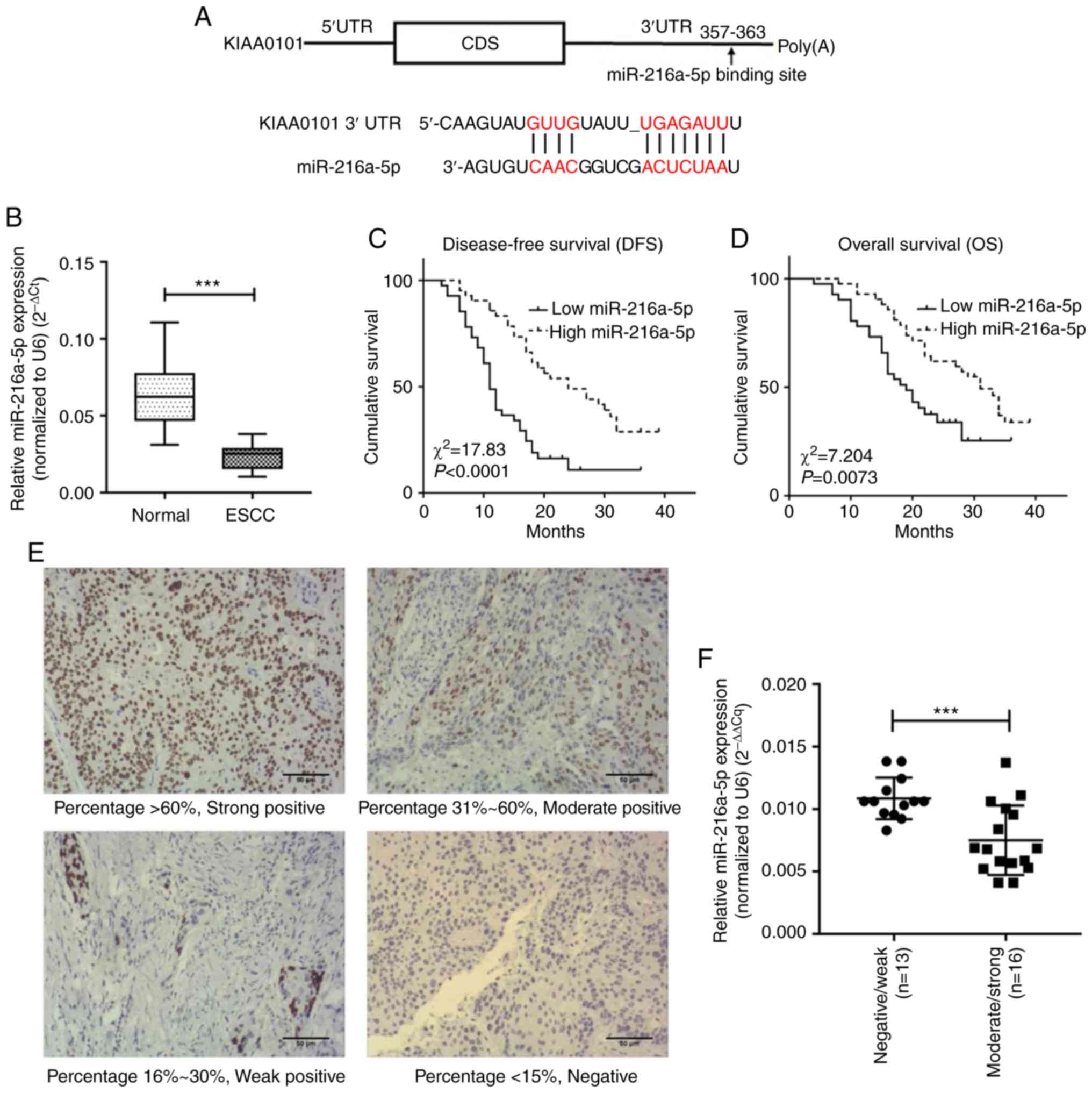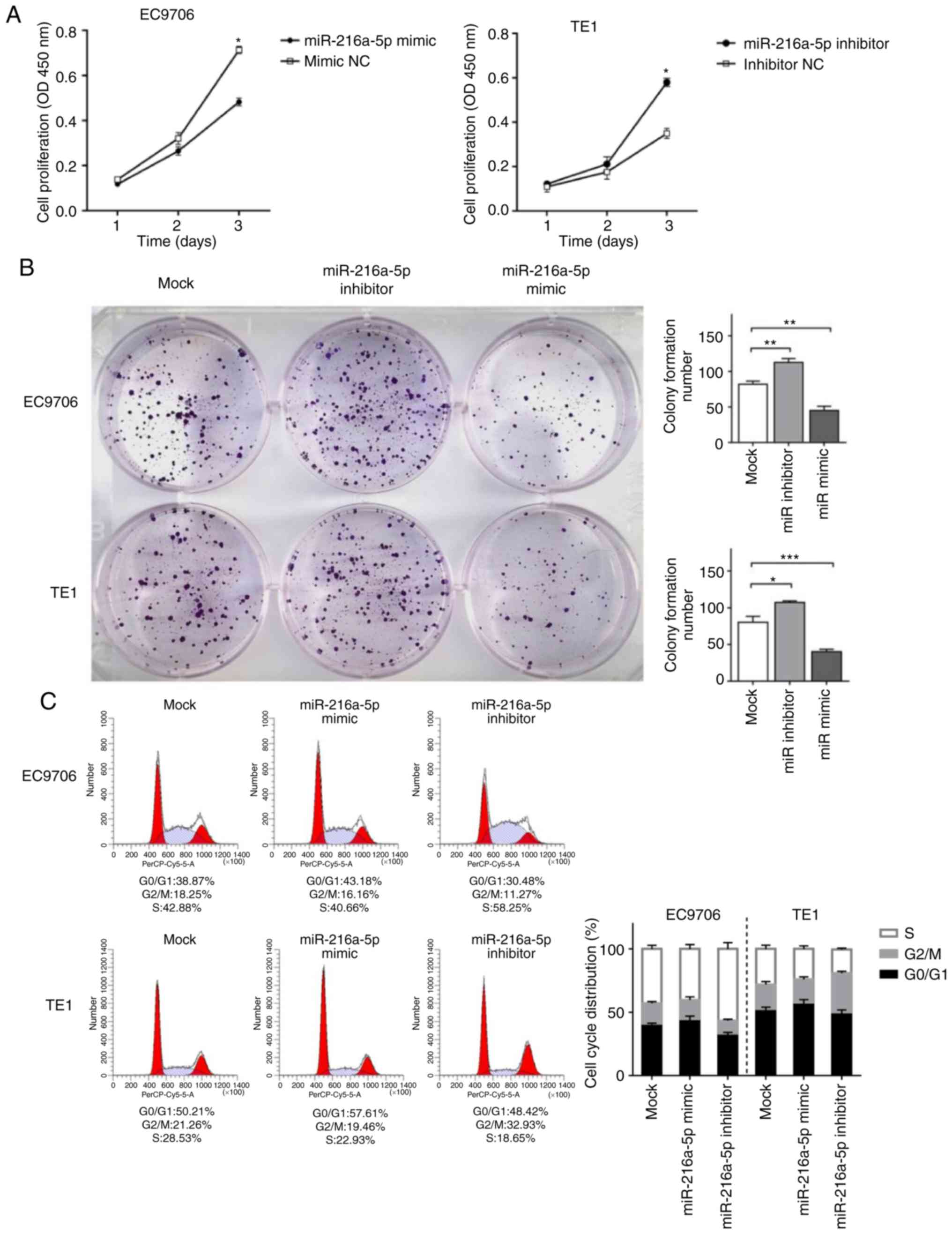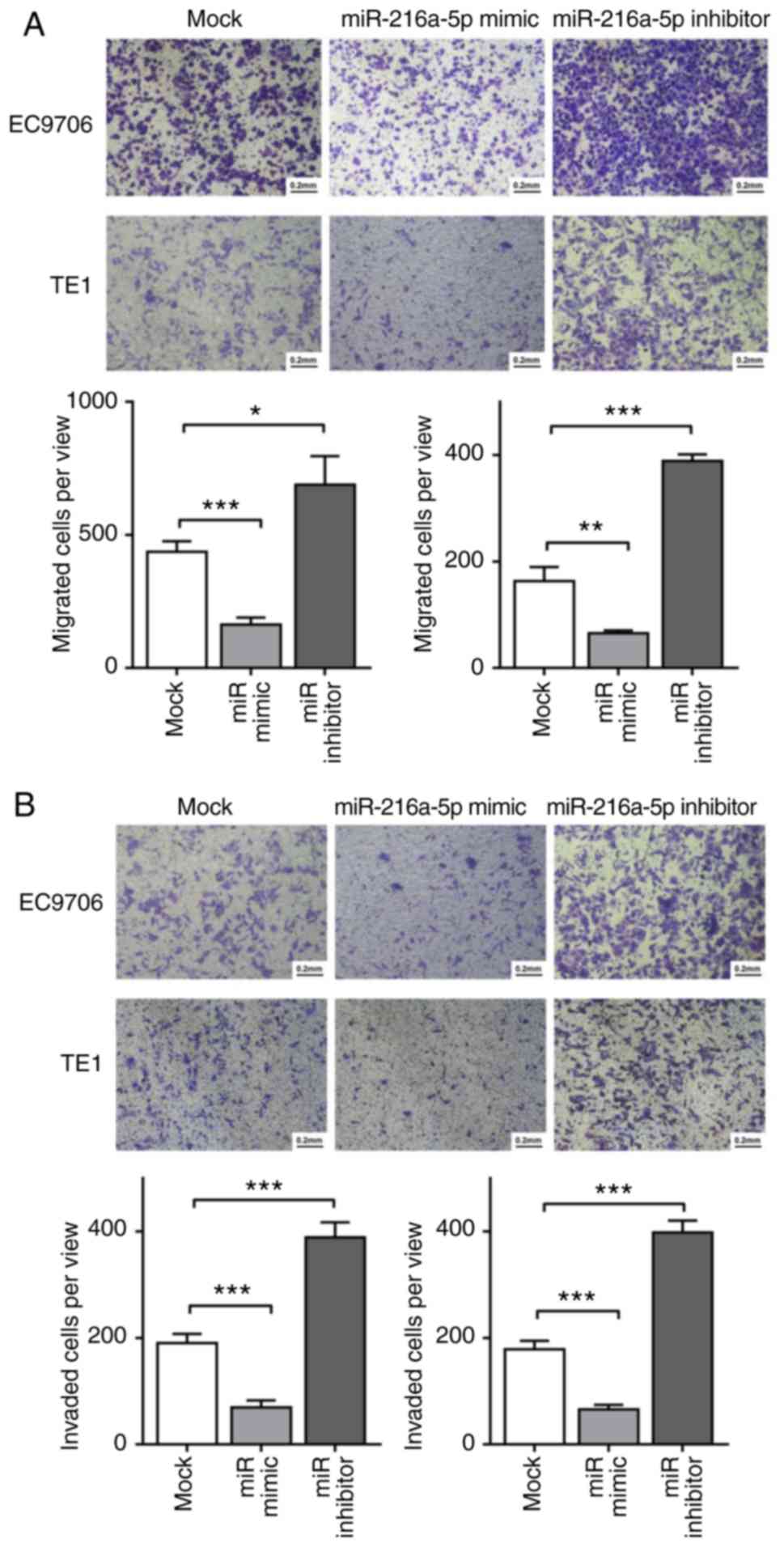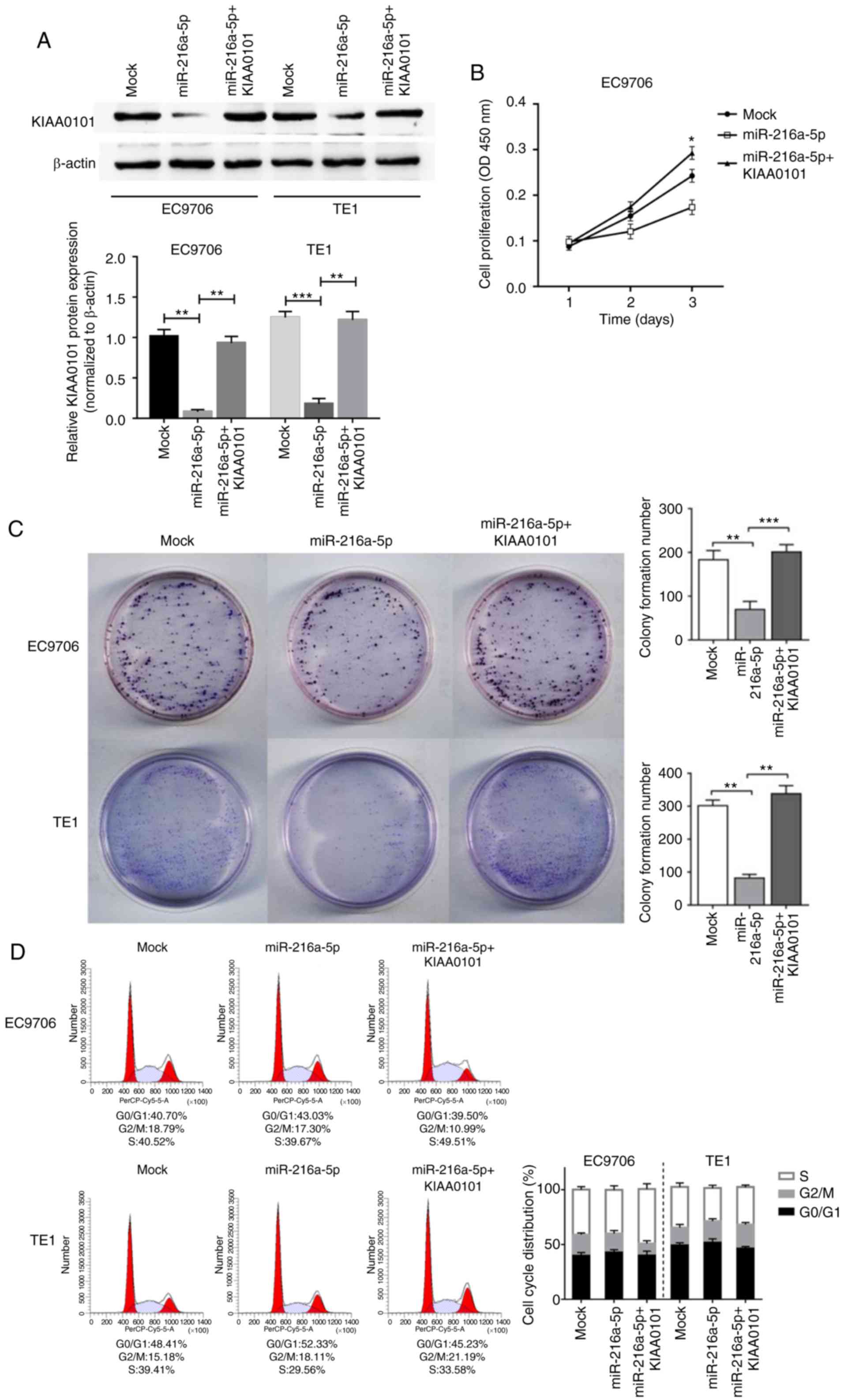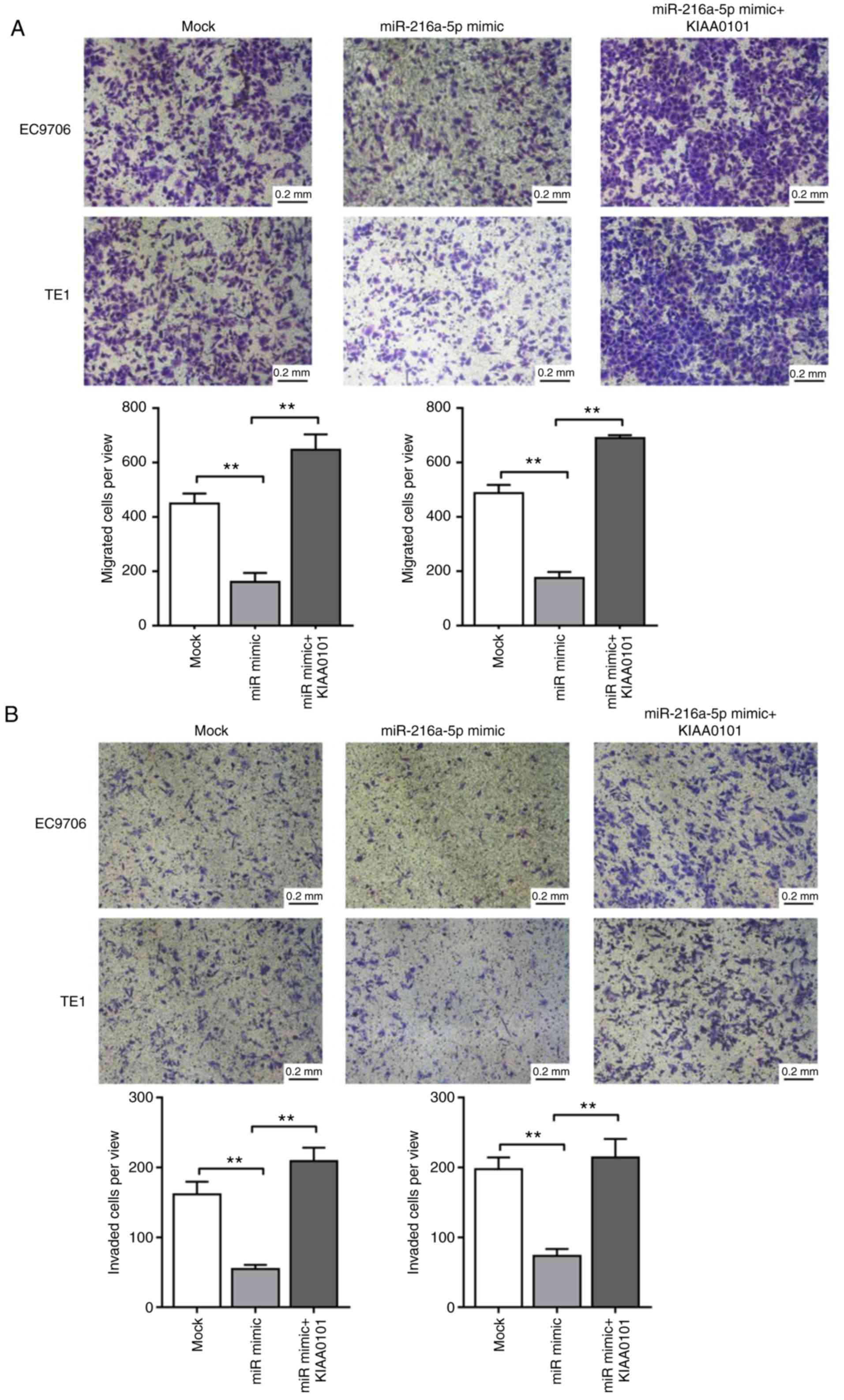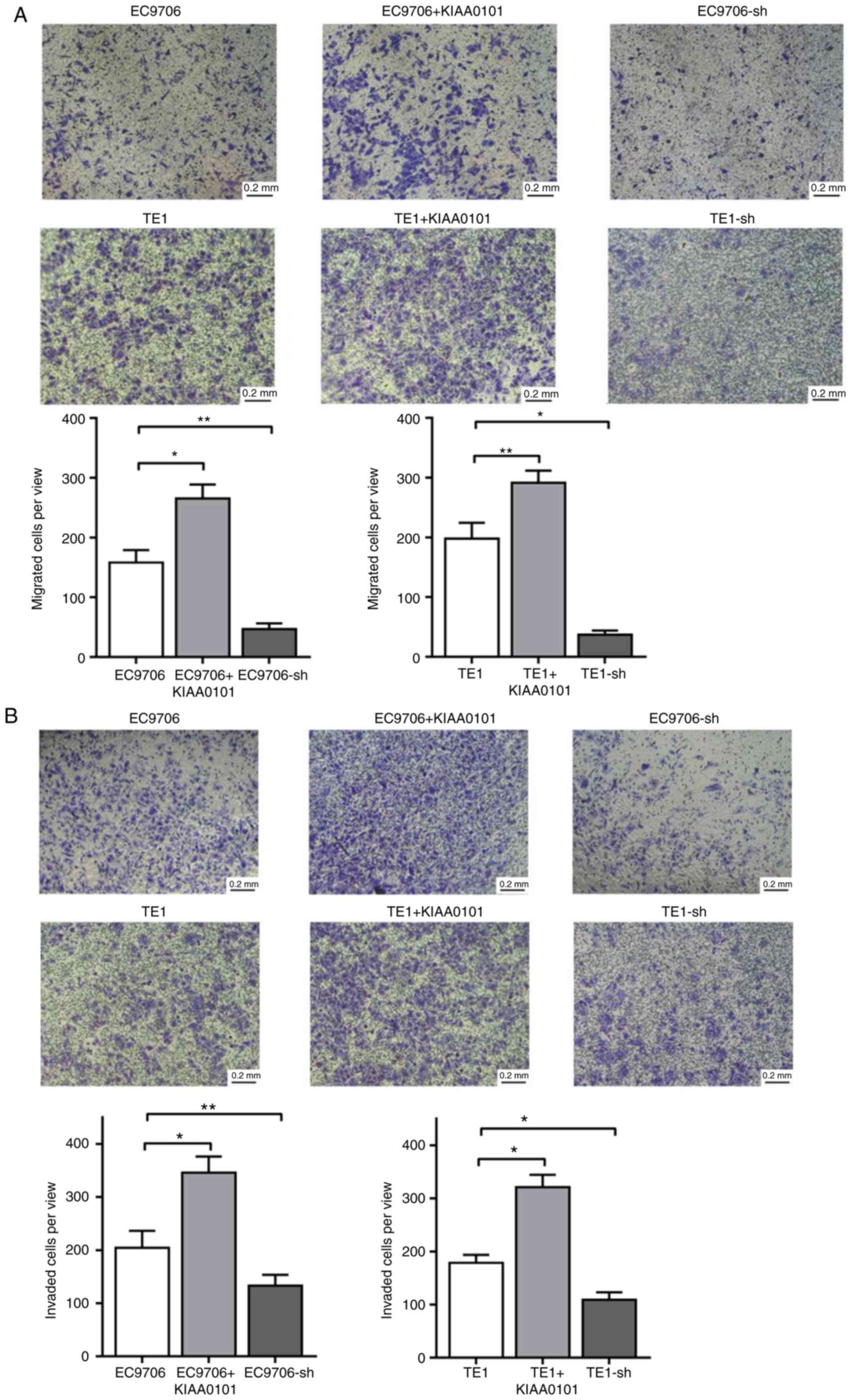Introduction
Esophageal cancer is one of the most commonly
diagnosed malignant tumors; 572,034 cases of newly diagnosed
esophageal cancer were estimated in 2018 worldwide (1,2).
Esophageal squamous cell carcinoma (ESCC) accounts for
approximately 90% of all esophageal cancers in Asian countries
(3). Despite advances in
therapeutic methods, the prognosis for patients with ESCC remains
poor due to the late stage at diagnosis in most cases. Studies
during the past three decades have identified a number of genetic
alterations involved in regulating the initiation and progression
of ESCC (4). Nevertheless, the
molecular mechanisms involved in the progression of ESCC are not
fully understood.
KIAA0101 (also referred to as NS5ATP9 or Paf15) is
involved in multiple biological activities, including DNA repair,
cell proliferation, cell cycle progression, and cell migration
(5). Previous studies have shown
that the KIAA0101 protein is dysregulated in a variety of malignant
tumors and that its overexpression is associated with poor
prognosis in patients with cancer (6–8). A
recent study by our group showed that KIAA0101 protein expression
was upregulated in ESCC tissues, and is associated with the
pathological Tumor-Node-Metastasis (pTNM) stage, resistance to
chemotherapy, tumor recurrence, and poor survival of patients with
ESCC (7). The overexpression of
KIAA0101 was also found to enhance ESCC cell proliferation and to
upregulate the expression of cyclins A and B, thus leading to a
reduced percentage of cells in the G1 phase (7). Nevertheless, the molecules that could
regulate the expression of KIAA0101 in ESCC cells have not been
elucidated to date.
MicroRNAs (miRNAs/miRs) are a class of small
non-coding RNA molecules that control specific gene expression by
translational repression or degradation of the complementary
messenger RNAs (mRNAs) (6). miRNAs
play important regulatory roles in cell differentiation,
proliferation, invasion, metastasis, and apoptosis (9). Currently, data are available on the
miRNA signature of ESCC, and there are studies attempting to point
out the potential value of miRNAs in ESCC screening, diagnosis,
treatment, and prognosis (10).
miR-216a-5p is a member of the miR-216 family
(miR-216a/miR-216b), which has been shown to be dysregulated in
several types of human cancers (11–16).
For example, miR-216a is significantly upregulated in
hepatocellular carcinoma and was found to induce
epithelial-mesenchymal transition (EMT) by suppressing the
expression of PTEN, SMAD7, and TSLC1, thus contributing to
carcinogenesis and recurrence (17). On the other hand, miR-216a displays
a low expression in non-small cell lung cancer (NSCLC) and could
inhibit the cell activity of NSCLC by directly targeting eIF4B and
ZEB1 (18). The role of miR-216a
and the underlying molecular mechanisms in ESCC have rarely been
explored.
A previous study by our group indicated that the
overexpression of KIAA0101 induced ESCC cell viability and was a
marker for poor prognosis of ESCC, including early recurrence and
short survival. In addition, KIAA0101 enhanced resistance to
cisplatin by upregulating cell mitosis (7). Therefore, we conducted a preliminary
exploration of its upstream regulation. By using TargetScan and
miRanda, we chose to study miR-216a-5p. In the present study, we
evaluated the expression level of miR-216a-5p in clinical specimens
of ESCC and human ESCC cell lines and observed that lower
expression of miR-216a-5p was associated with malignancy in
comparison with the control tissues or cells. We examined the
association between miR-216a-5p expression and prognosis of
patients with ESCC. KIAA0101 was confirmed to be a downstream
target of miR-216a-5p, and the in vitro experimental results
demonstrated that miR-216a-5p inhibited tumor proliferation,
migration, and invasion by directly decreasing the expression of
KIAA0101 in ESCC. Our study demonstrated a critical role of the
miR216a-5p/KIAA0101 axis in the progression of ESCC.
Materials and methods
Study population, tissue samples, and
collection of survival data
Between July 2014 and June 2017, 83 patients with
unifocal primary ESCC (histologically diagnosed) were recruited at
the Department of Oncologic Surgery of the First Affiliated
Hospital of Xi'an Jiaotong University (Xi'an, Shaanxi, China).
During the operation, tumor and corresponding normal tissues (>5
cm from the edge of the tumor) were collected and immediately
stored at −80°C until use. All patients underwent margin-negative
complete tumor resection (R0 resection) and extensive
lymphadenectomy. Patients with advanced-stage cancer received
5-FU/leucovorin-based postoperative chemotherapy and radiotherapy.
Tumor stage and histological grade were recorded according to the
7th edition of the classification guidelines of the American Joint
Committee on Cancer (AJCC) (19).
After surgery, the patients were followed routinely for more than
36 months or until death. The follow-up was censored in February
2019. The overall survival (OS) and disease-free survival (DFS)
rates were calculated with the Kaplan-Meier method. The study was
approved by the Ethics Committee at the First Affiliated Hospital
of Xi'an Jiaotong University. Written informed consent was obtained
from all patients.
Cell culture
Six human ESCC cell lines (EC9706, EC109, KYSE150,
KYSE450, TE1, and TE10) were obtained from the Type Culture
Collection of the Chinese Academy of Sciences (Shanghai, China).
The human esophageal epithelial cell line (HET1A) was obtained from
the American Type Culture Collection (ATCC). EC9706, EC109,
KYSE150, KYSE450, TE1, and TE10 cells were cultured in RPMI-1640
medium (HyClone; GE Healthcare) containing 10% fetal bovine serum
(FSB; HyClone; GE Healthcare) and 1% penicillin/streptomycin
(Sigma-Aldrich; Merck KGaA). The HET1A cells were cultured in
Dulbecco's modified Eagle's medium (DMEM; HyClone; GE Healthcare)
supplemented with 10% FBS and 1% penicillin/streptomycin. All cells
were grown in a humidified atmosphere with 5% CO2 at
37°C.
Cell transfection
In order to overexpress KIAA0101, the full-length
KIAA0101 cDNA was cloned into the mammalian expression vector
p-EGFP (RiboBio, China) to generate the KIAA0101-overexpressing
plasmid. The empty p-EGFP plasmid was used as a control. The
plasmids were transfected into the cell lines using Lipofectamine
2000 (Invitrogen; Thermo Fisher Scientific, Inc.), according to the
manufacturer's instructions. At 48 h after transfection,
G418-sulfate (600 ng/ml for EC9706, and 800 ng/ml for TE1;
Sigma-Aldrich; Merck KGaA) was added to the cell culture medium
throughout the experimental periods, as previously described
(7). In order to knock down
KIAA0101, the ESCC cells were transfected with the pSIREN-Shuttle
vector (RiboBio) encoding the KIAA0101-targeted shRNA
(5′-GCAACCTGATCACACAAATGA-3′) using Xtreme HP (Roche), according to
the manufacturer's instructions. For the transfection of small RNA
molecules, ESCC cells were cultured in 6-well plates
(2×105 cells per well), and the miR-216a-5p mimic (30
nM), or the miR-216a-5p inhibitor (300 nM), or the negative
controls (all were from RiboBio) were transfected into cells using
Lipofectamine RNAiMAX (Life Technologies; Thermo Fisher Scientific,
Inc.). The cells were used at 48 h after transfection.
Real-time qPCR
Total RNA was extracted from the cultured cells and
tissues using TRIzol (Invitrogen; Thermo Fisher Scientific, Inc.)
according to the manufacturer's protocols. RNA concentrations were
measured using a NanoDrop1000 spectrophotometer (NanoDrop
Technologies). RNA integrity was assessed by gel electrophoresis.
To detect the expression levels of miR-216a-5p, the
miR-216a-5p-specific primers (RiboBio) were used for the reverse
transcription of the total RNA. To detect the expression levels of
KIAA0101, total RNA (1 µg each sample) was used to synthesize cDNA
using the PrimeScript® RT Master Mix Perfect Real-Time
Reagent Kit (Takara Bio Inc.). Quantitative reverse transcription
PCR (RT-qPCR) for miR-216a-5p and KIAA0101 was performed using a
standard protocol based on the SYBR Green PCR kit (Toyobo) on an
iQ5 system (Bio-Rad Laboratories, Inc.). The relative expression of
miR-216a-5p was normalized against U6, while that of KIAA0101 was
normalized to β-actin, both using the 2−ΔΔCq method
(20). When comparing the ΔCq
between tumor and normal tissue, 2−ΔCq was used. When
normal cells or tissue were used as references, 2−ΔΔCq
was compared. The 2−ΔΔCq of normal tissue was 1. Each
sample was run in triplicates, and the experiment was repeated at
least twice.
Western blotting
Total protein was extracted from cultured cells or
tissues using the radioimmunoprecipitation assay lysis buffer
(RIPA; Beyotime Institute of Biotechnology). Protein concentration
was measured using the BCA kit (Beyotime Institute of
Biotechnologya). Western blotting was performed as previously
described (7). The primary
antibodies included KIAA0101 (dilution 1:500, 15 kDa; cat. no.
H0009768-M01; Abnova) and β-actin (dilution 1:1,500, 42 kDa; cat.
no. sc-47778; Santa Cruz Biotechnology, Inc.). The secondary
antibody was goat anti-mouse antibodies conjugated to horseradish
peroxidase (HRP; dilution 1:1,000; cat. no. 31430; Pierce
Biotechnology; Thermo Fisher Scientific, Inc.). Proteins of
interest were visualized using an enhanced chemiluminescence kit
(EMD Millipore). The band intensities were quantified by
densitometry using ImageJ software (version 1.8.0; National
Institutes of Health, Bethesda, MD, USA). Each experiment was
repeated at least three times.
Immunohistochemistry
Immunohistochemistry was carried out as previously
described (21), using the primary
antibody for KIAA0101 (dilution 1:300; Abnova) and a secondary
antibody (goat anti-mouse IgG; Pierce Biotechnology; Thermo Fisher
Scientific, Inc.). By calculating the percentage of
KIAA0101-positive cancer cells as previously described (7), all samples were classified into two
groups: Negative or weak KIAA0101 expression (<15% or 16–30%)
and positive or strong KIAA0101 expression (31–60% or >60%). All
slides were independently assessed by at least two pathologists who
were unaware of the clinicopathological features of the tumors.
Dual-luciferase reporter assay
The KIAA0101 3′-UTR containing the binding sites of
miR-216a-5p was amplified by PCR and inserted into the firefly
luciferase reporter vector pmiR-RB-REPORT (RiboBio). Following the
manual of Gene Tailor Site-Directed Mutagenesis System (Invitrogen;
Thermo Fisher Scientific, Inc.), the construct with mutations in
the miR-216a-5p seed sequence (the sequence of TGAGATT at 357–363
bp was mutated to TCACAAT) was produced by the mutagenic
oligonucleotide primers (forward: 5′-GTTGTATTTCACAATTGCTTAGATTGTTGTAC-3′ and
reverse: 5′-CTAAGCAATTGTGAAATACAACATACTTGTAA-3′). EC9706 and TE1
cells were co-transfected with 30 ng of pmiR-RB-KIAA0101 3′-UTR or
their mutant constructs, 50 ng luciferase reporter, and 10 ng
Renilla luciferase reporter using Lipofectamine 2000. At 24
h after transfection, the firefly and Renilla luciferase
activities were measured using the dual-luciferase reporter assay
system (Promega Corp.). For each analysis, the Renilla
luciferase signal was standardized to the firefly luciferase
signal.
Cell proliferation
At 24 h before transfection, the EC9706 and TE1
cells were seeded into 96-well plates at 5,000 cells/well. At 48 h
after transfection with the KIAA0101-expressing or
KIAA0101-specific shRNA expressing plasmids, the cells were
assessed using the Cell Counting Kit 8 reagent (CCK-8,
Sigma-Aldrich; Merck KGaA) for proliferation, following the
manufacturer's instructions. Cell viability was quantified by
measuring absorbance at 450 nm on a microplate reader. The optical
density (OD) values of the samples in the experimental groups were
normalized to that of the groups with control transfection at each
time point. Each experiment was repeated at least three times.
Colony formation
EC9706 and TE1 cells were trypsinized and incubated
in 6-well plates (1,000 cells/well) in a humidified 5%
CO2 atmosphere for 10 days. The colonies were fixed with
70% ethanol for 15 min at room temperature and stained with 2%
crystal violet. The positive colonies (more than 50 cells or 3
mm2 per colony) were counted. Images of stained sections
were obtained using an Olympus BX51 optical microscope (Olympus
Corp.) equipped with a digital camera (PD71; Olympus). The
experiments were repeated at least three times.
Flow cytometry
The cultured EC9706 and TE1 cells were digested with
trypsin, washed with phosphate-buffered solution (PBS), and fixed
with 70% ethanol overnight at 4°C. The cells were incubated with
DNase-free RNase (100 µg/ml; Thermo Fisher Scientific, Inc.) for 20
min at 37°C, and stained with propidium iodide (PI) (50 µg/ml;
Sigma-Aldrich; Merck KGaA). The DNA contents were determined using
the FACSCalibur™ platform (BD Biosciences), following the
manufacturer's instructions. The data were generated from 20,000
events (cells) using the ModFit LT software (Verity Software House,
USA).
Cell migration and invasion
assays
The migration and invasion assays were carried out
using Transwells with 6.5-mm polycarbonate membranes and 8.0-µm
pores (Corning, Inc.) with and without Matrigel (BD Biosciences). A
total of 1×105 EC9706 or TE1 cells were seeded in the
upper chambers. In the migration and invasion experiments, we used
a serum-free RPMI-1640 medium in the upper chamber, and a medium
containing 10% FBS in the lower chamber to avoid the influence of
cell proliferation. We determined the time of observation and
counting according to the proliferation cycle and growth of the two
types of cells and avoided the effects of cell proliferation as
much as possible. After incubation at 37°C for 24 h, the cells in
the chambers were stained with 0.1% crystal violet, observed under
a light microscope (IX71; Olympus), and photographed at ×200
magnification.
Statistical analysis
Data are presented as mean ± standard error of the
mean (SEM). The differences between ESCC and corresponding normal
tissues were compared using the Wilcoxon t-test. The correlations
between miR-216a-5p expression and the clinicopathological features
of the patients with ESCC were evaluated using the Chi-square test.
The independent risk factors associated with the survival of the
patients with ESCC were identified by Cox proportional hazards
regression analysis. The survival curves of the patients with ESCC
were obtained using the Kaplan-Meier method, and the survival rates
were compared using the log-rank test. The significance level was
set to P<0.05. Data analysis was performed using SPSS 20.0 (IBM,
Corp.) and Graph Pad Prism 5 (GraphPad Software, Inc.).
Results
Lower expression of miR-216a-5p
predicts worse prognosis of the ESCC patients
To explore the potential roles of miR-216a-5p in the
pathogenesis and chemoresistance of ESCC, we first evaluated the
binding site of miR-216a-5p to the 3′UTR of KIAA0101. We found that
miR-216a-5p could bind the 3′UTR of KIAA0101 (Fig. 1A), which suggests that miR-216a-5p
directly targets the KIAA0101 mRNA. Then, the expression levels of
miR-216a-5p were examined in 29 ESCC specimens. RT-qPCR analysis
demonstrated that compared with the adjacent normal tissues, the
tumor tissues had significantly lower expression of miR-216a-5p
(Fig. 1B). We next examined the
miR-216a-5p expression in 83 human ESCC specimens to investigate
the relationship between miR-216a-5p expression and the prognosis
of patients with ESCC. The patients with ESCC were categorized into
high- or low-expression groups using a cut-off value according to
the median miR-216a-5p expression level. The miR-216a-5p expression
levels in ESCC were not correlated with sex, age, pTNM stage, or
preoperative CEA levels, but were correlated with histology
(P=0.022), tumor depth (P=0.006), and lymph node metastasis
(P=0.018; Table I). In addition,
the Cox regression analysis (Table
II) revealed that the lymph node metastasis (P=0.001), pTNM
stage (P<0.001), and miR-216a-5p levels (P<0.001) were
independent risk factors for shorter overall survival in patients
with ESCC. Furthermore, patients with ESCC and lower miR-216a-5p
expression displayed reduced DFS (P<0.0001; Fig. 1C) and OS (P=0.0073; Fig. 1D). Immunohistochemistry was carried
out to examine the expression of KIAA0101 in ESCC specimens
(Fig. 1E). Lower miR-216a-5p
expression in ESCC specimens was accompanied by higher KIAA0101
protein expression (P<0.001, Fig. 1E
and F). Taken together, miR-216a-5p expression was low in ESCC
specimens, and its expression was inversely correlated with
KIAA0101 protein expression.
 | Table I.Association between miR-216a-5p
expression and the clinicopathological characteristics of the ESCC
patients. |
Table I.
Association between miR-216a-5p
expression and the clinicopathological characteristics of the ESCC
patients.
|
|
| miR-216a-5p
expression |
|
|---|
|
|
|
|
|
|---|
|
Characteristics | All cases n
(%) | High n (%) | Low n (%) | P-value |
|---|
| Total | 83 (100) | 42 (50.6) | 41 (49.4) |
|
| Sex |
|
|
| 0.679 |
|
Male | 59 (71.1) | 29 (49.2) | 30 (50.8) |
|
|
Female | 24 (28.9) | 13 (54.2) | 11 (45.8) |
|
| Age (years) |
|
|
| 0.573 |
|
<60 | 37 (44.6) | 20 (54.1) | 17 (45.9) |
|
|
≥60 | 46 (55.4) | 22 (47.8) | 24 (52.2) |
|
| Histology |
|
|
| 0.022 |
|
Differentiated | 64 (77.1) | 28 (43.8) | 36 (56.3) |
|
|
Undifferentiated | 19 (22.9) | 14 (73.7) | 5 (26.3) |
|
| Tumor depth |
|
|
| 0.006 |
|
T1-T2 | 40 (48.2) | 14 (35.0) | 26 (65.0) |
|
|
T3-T4 | 43 (51.8) | 28 (65.1) | 15 (34.9) |
|
| Lymph node
metastasis |
|
|
| 0.018 |
|
Negative | 30 (36.1) | 10 (33.3) | 20 (66.7) |
|
|
Positive | 53 (63.9) | 32 (60.4) | 21 (39.6) |
|
| pTNM stage |
|
|
| 0.097 |
|
I–II | 33 (39.8) | 13 (39.4) | 20 (60.6) |
|
|
III | 50 (60.2) | 29 (58.0) | 21 (42.0) |
|
| Preoperative
CEA |
|
|
| 0.588 |
|
<3.5 | 45 (54.2) | 24 (53.3) | 21 (46.7) |
|
|
≥3.5 | 38 (45.8) | 18 (47.4) | 20 (52.6) |
|
 | Table II.Cox proportional hazards regression
model of the prognostic variables for overall survival. |
Table II.
Cox proportional hazards regression
model of the prognostic variables for overall survival.
| Prognostic
variable | P-value | Risk ratio (95%
CI) |
|---|
| miR-216a-5p
expression |
<0.001 | 10.46
(4.58–23.88) |
| Sex | 0.172 | 1.55
(0.83–2.93) |
| Age | 0.656 | 0.87
(0.47–1.62) |
| Histology | 0.159 | 1.73
(0.81–3.70) |
| Tumor depth | 0.315 | 0.72
(0.38–1.37) |
| Lymph node
metastasis | 0.001 | 0.18
(0.06–0.49) |
| pTNM stage |
<0.001 | 0.18
(0.08–0.42) |
| Preoperative
CEA | 0.809 | 0.93
(0.50–1.71) |
miR-216a-5p regulates the protein
expression of the downstream target KIAA0101 by binding its 3′UTR
in ESCC
We next examined the miR-216a-5p expression levels
in ESCC cell lines. The six common ESCC cell lines, including
EC109, TE1, TE10, KYSE150, KYSE450, and EC9706, demonstrated a
marked reduction in miR-216a-5p expression (Fig. 2A) and significant increase in
KIAA0101 protein expression (Fig.
2B) compared with the normal esophageal epithelial HET1A
cells.
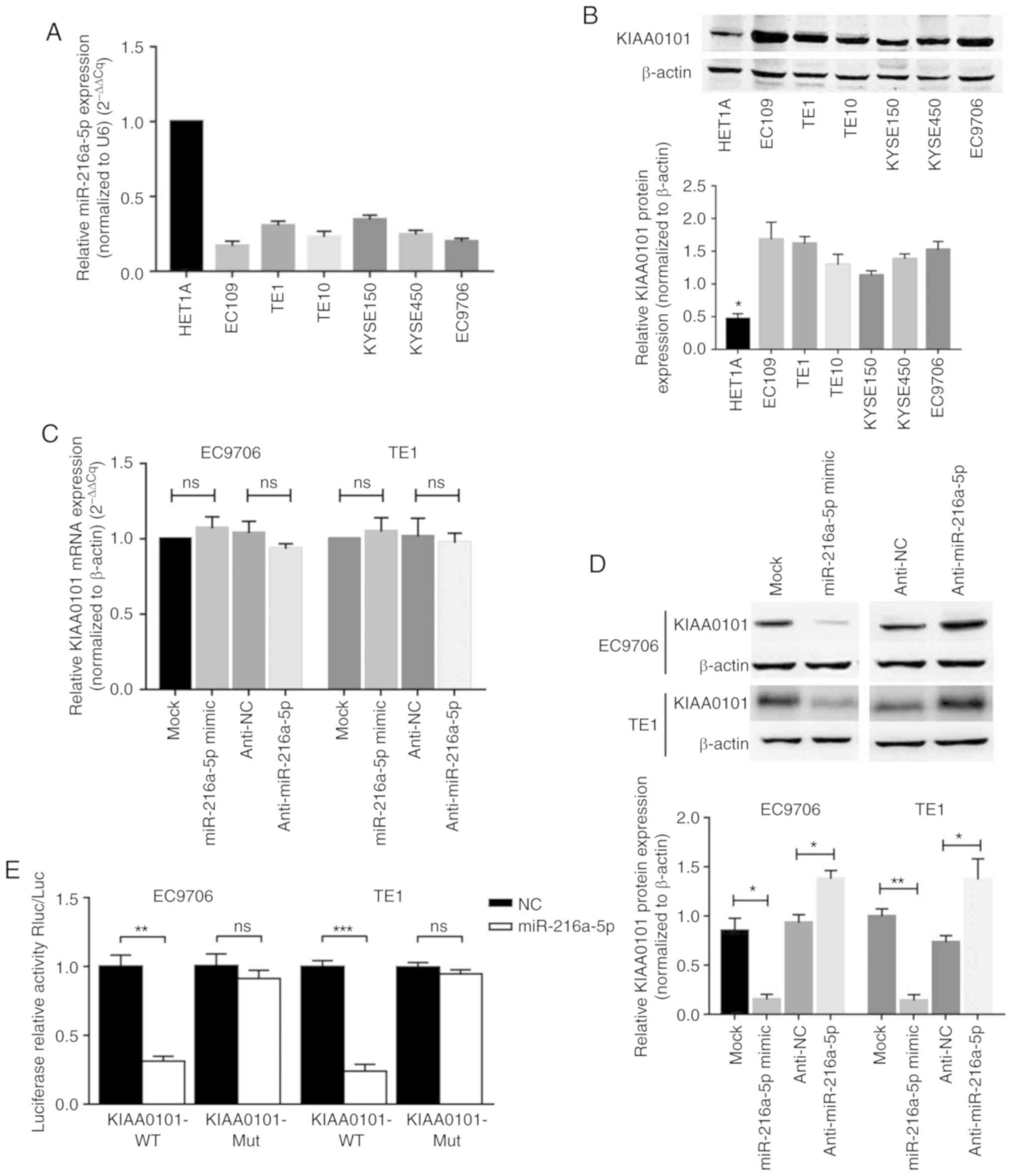 | Figure 2.KIAA0101 is a downstream target of
miR-216a-5p, and its expression is inversely correlated with
miR-216a-5p expression level in ESCC. (A) miR-216a-5p expression
level in the human normal esophageal epithelial HET1A cells and six
human ESCC cell lines (EC109, TE1, TE10, KYSE150, KYSE450, and
EC9706) were quantified by qPCR. Values were calculated using the
2−ΔΔCq method, normalized to U6. (B) Expression of
KIAA0101 protein (15 kDa) and β-actin (42 kDa) in the indicated
cell lines was quantified by western blot analysis. Representative
western blot images are shown (upper panel), and the band
intensities were summarized (lower panel; n=3 for each group).
*P<0.05, HET1A cells compared with the ESCC cell lines. (C) The
mRNA level of KIAA0101 in EC9706 and TE1 cells transfected with
miR-216a-5p mimic, or inhibitor (Anti-miR-216a-5p), or the
corresponding controls (Mock and Anti-NC) was determined by qPCR.
n=3 for each group. Values were calculated using the
2−ΔΔCq method, normalized to β-actin. ns not
significant. (D) The protein levels of KIAA0101 in EC9706 and TE1
cells with the indicated transfection were determined by western
blot analysis. Representative western blot images are shown (upper
panel), and the band intensities were summarized (lower panel; n=3
for each group). *P<0.05 and **P<0.01. (E) Compared with the
controls, miR-216a-5p inhibited the reporter activities of the
vector with the wild-type (WT), but not the mutant-type (MUT) of 3′
UTR of KIAA0101 in EC9706 and TE1 cells in the dual-luciferase
assays. **P<0.01 and ***P<0.001; ns, not significant. ESCC,
esophageal squamous cell carcinoma. |
We then selected the EC9706 and TE1 cells since they
maintained moderate expression levels of both miR-216a-5p and
KIAA0101 molecules among the six cell lines. To ascertain whether
miR-216a-5p functionally affects KIAA0101 expression, miR-216a-5p
was overexpressed and knocked down by transfecting the ESCC cell
lines EC9706 and TE1 with the miR-216a-5p mimics and miR-216a-5p
inhibitor. The transfections of the miR-216a-5p mimic and
anti-miR-216a-5p were confirmed by RT-PCR (Fig. S1A). When compared to those
transfected with the control mimic (Mock) or inhibitor (Anti-NC),
the miR-216a-5p-specific mimic or inhibitor (Anti-miR-216a-5p) did
not significantly change the mRNA levels of KIAA0101 (Fig. 2C). Transfection of the miR-216a-5p
mimics resulted in downregulation of the KIAA0101 protein levels in
EC9706 and TE1 cells, and transfection of the miR-216a-5p inhibitor
upregulated the KIAA0101 protein levels (Fig. 2D). These results indicated that
miR-216a-5p regulated the expression of KIAA0101 in ESCC cells in a
post-transcriptional manner. We then co-transfected the luciferase
reporter constructs into EC9706 and TE1 cells together with the
miR-216a-5p mimics or NC controls. The relative luciferase activity
was significantly decreased in the cells transfected with the
KIAA0101-WT-3′-UTR vector together with miR-216a-5p mimics,
compared with that in the cells transfected with the plasmid of
corresponding mutant (Mut) sites and NC controls (Fig. 2E). Therefore, this finding revealed
that miR-216a-5p could reduce the expression of KIAA0101 protein by
directly binding to the 3′UTR of KIAA0101 and possible translation
suppression.
miR-216a-5p regulates cell cycle
progression and inhibits the proliferation, migration, and invasion
of ESCC cells by targeting KIAA0101
The inverse correlation between miR-216a-5p and
KIAA0101 expressions drove us to investigate the possible
biological functions of miR-216a-5p in ESCC cells. The CCK-8 assays
(Fig. 3A), colony formation assays
(Fig. 3B), and flow cytometry
assays (Fig. 3C) revealed that
miR-216a-5p overexpression through transfection of the miR-216a-5p
mimics significantly decreased ESCC cell proliferation, suppressed
colony formation, and induced cell cycle arrest at G0/G1 phase in
EC9706 and TE1 cells, whereas inhibition of miR-216a-5p through
transfection of the miR-216a-5p inhibitor had the opposite effects.
In addition, Transwell assays were carried out on the ESCC cells to
examine the roles of miR-216a-5p in cell migration and invasion.
Overexpression of miR-216a-5p significantly suppressed the ESCC
invasion and reduced the ESCC migration. In contrast, the migration
and invasion of ESCC cells increased when endogenous miR-216a-5p
was inhibited (Fig. 4A and B).
Ectopic KIAA0101 expression attenuates
the effects of miR-216a-5p in ESCC cells
As shown in Fig.
S1B, transfection with KIAA0101 alone increased the protein
expression of KIAA0101 in EC9706 and TE1 cells, while transfection
with the KIAA0101-targeted shRNA decreased the expression of
KIAA0101. As shown in Fig. 5A,
transfection of KIAA0101 reversed the decreased expression of
KIAA0101 that was mediated by the transfection of the miR-216a-5p
mimic. The CCK-8 assays (Fig. 5B),
colony formation assays (Fig. 5C),
and flow cytometry assays (Fig. 5D)
also demonstrated that KIAA0101 ectopic expression significantly
attenuated the anti-proliferative effects of miR-216a-5p.
Meanwhile, additionally forced KIAA0101 expression in ESCC cells
restored the migration and invasion inhibition induced by
overexpression of miR-216a-5p (Fig. 6A
and B).
KIAA0101 promotes the migration and
invasion of ESCC cells
These results also indicate that KIAA0101 functions
as an oncogene in ESCC. Thus, we further evaluated the impact of
KIAA0101 overexpression and knockdown on the migration and invasion
of EC9706 and TE1 cells. Compared with the control cells without
transfection, KIAA0101 overexpression significantly enhanced ESCC
cell migration and invasion, while KIAA0101 knockdown remarkably
inhibited ESCC cell migration and invasion (Fig. 7). Collectively, overexpression of
miR-216a-5p can inhibit the in vitro proliferation,
migration, and invasion of ESCC cells through targeting the
oncogene KIAA0101.
Discussion
Esophageal squamous cell carcinoma (ESCC) is one of
the most commonly diagnosed malignant tumors of the digestive tract
in Asian countries, especially in China (22). It is urgently needed to understand
the precise molecular mechanisms underlying ESCC tumorigenesis in
order to develop more accurate diagnosis and therapy for patients.
In the present study, we identified that miR-216a-5p expression was
significantly downregulated in primary human ESCC specimens and
cell lines, and demonstrated an inverse correlation with KIAA0101
expression. The patients with lower miR-216a-5p expression in
tumors had worse disease-free survival (DFS) and overall survival
(OS) than the patients with higher miR-216a-5p expression. KIAA0101
was validated to be a direct downstream target of miR-216a-5p, and
its expression in ESCC cells was regulated by miR-216a-5p at the
translational level. miR-216a-5p overexpression through the
transfection of miR-216-5p mimics markedly inhibited cell
proliferation, cell cycle progression, migration, and invasion of
EC9706 and TE1 cells, and additional overexpression of the oncogene
KIAA0101 remarkably reversed the antitumor effects of miR-216a-5p
mimics. Our data demonstrated that the miR-216a-5p/KIAA0101 axis
contributes to the progression of ESCC, and represents a valuable
prognosis marker and therapeutic target for patients with ESCC.
As a PCNA-associated protein, KIAA0101 plays an
important role in DNA replication, DNA repair, cell cycle
progression, and cell proliferation (5,23–25).
KIAA0101 overexpression is associated with the progression and poor
prognosis of several cancers, including hepatocellular carcinoma
(26), pancreatic cancer (27), breast cancer (28), lung cancer (29), gastric cancer (30), and esophageal cancer (9). A previous study by our group indicated
that the overexpression of KIAA0101 induced ESCC cell viability and
was a marker for poor prognosis of ESCC, including early recurrence
and short survival. In addition, KIAA0101 was found to enhance
resistance to cisplatin by upregulating cell mitosis (7). Herein we identified miR-216a-5p as an
upstream regulator of KIAA0101 that was inversely correlated with
KIAA0101. Consistent with the previous results, lower levels of
miR-216a-5p in ESCC specimens corresponded to a higher level of
KIAA0101 and less favorable prognosis for patients with ESCC.
Our findings suggest that by repressing KIAA0101
protein, miR-216a-5p plays an essential role in suppressing the
proliferation and metastasis of ESCC. Evidence reveals that the
abnormal expression of miR-216a is involved in tumorigenesis and
cancer progression (11–16), but the specific role of miR-216a
seems to be cell type-dependent. miR-216a has a low expression in
NSCLC specimens and could inhibit cell activity of NSCLC (18), which was in accordance with
observations in oral squamous cell carcinoma (31). In addition, Wang et al
identified that miR-216a negatively regulated the progression of
pancreatic cancer by direct interaction with JAK2 (32). These reports highlight the
tumor-suppressive role of miR-216a. Nevertheless, miR-216a was also
found to demonstrate a tumor-promoting role, and its expression
affected the therapeutic effects of anticancer treatments. In
hepatocellular carcinoma (HCC), upregulated expression of miR-216a
induced resistance to sorafenib (17). In NSCLC, it enhanced the sensitivity
of cells to cis-diamminedichloroplatinum/cisplatin (CDDP) (33). In addition, the diagnostic value of
circulating miR-216a has also been discovered. In acute
pancreatitis, the expression of miR-216a/b in plasma was
upregulated and had higher diagnostic specificity than amylase and
lipase (34). Link et al
found that decreased expression of fecal miR-216a could be used as
a non-invasive miRNA biomarker for pancreatic cancer (35). Similarly, compared to healthy
subjects, HCC patients had significantly downregulated miR-216b in
plasma (36).
In the present study, miR-216a-5p had lower
expression in ESCC specimens and cell lines than in the normal
control tissues and cells. In support of our findings on the
tumor-suppressive role of miR-216a-5p, a recent report also
identified the significantly downregulated miR-216a-5p expression
in ESCC specimens and cell lines (13). In addition, tectonic family member 1
(TCTN1) was proven to be another downstream target of miR-216a-5p
in ESCC, and the restoration of TCTN expression reversed the
effects of miR-216a-5p on cell proliferation and apoptosis
(13). Therefore, further
investigation of potential targets of miR-216a-5p is needed to
fully elucidate the functions of miR-216a-5p in ESCC
pathogenesis.
The current investigation has several strengths and
limitations. Its major strength is its novelty; to the best of our
knowledge, this is the first report to unveil the critical role of
the miR-216a-5p/KIAA0101 axis in ESCC pathogenesis. The present
research also provides a feasible framework for validating ESCC
progression in relation to candidate miRNA genes to facilitate the
diagnosis and implementation of more effective therapy of patients
with ESCC. One limitation of the present study is its sample size
of 83 patients and a single data source when evaluating the impacts
of tumor miR-216a-5p expression on patient survival. In addition,
due to the limited amount of material, extensive staining and
immunohistochemistry assays could not be carried out on the ESCC
specimens. This study only used cell lines, and future studies
should include animal models. Further work on validating the
therapeutic effects of administration of miR-216a-5p mimics and/or
knockdown of KIAA0101 in animals is warranted to substantiate the
potential of the miR-216a-5p/KIAA0101 axis-targeted therapy in
patients with ESCC. In addition, the lack of a CCK-8 assay prevents
the confirmation of the viability of the cells. Finally,
miR-216a-5p has targets other than KIAA0101 (36), and it is possible to modulate the
expression of miR-216a-5p affecting ESCC proliferation through
proteins other than KIAA0101. Nevertheless, modulating the
expression of KIAA0101 at least confirmed the role of KIAA0101 in
ESCC, but without excluding the potential involvement of other
proteins.
In summary, this is the first report that reveals
the targeting effect of miR-216a-5p on KIAA0101 expression in ESCC.
Our results demonstrated the antitumor effects of miR-216a-5p and
oncogenic effects of KIAA0101 in ESCC cells in terms of regulating
cell proliferation, cell cycle progression, migration, and
invasion. In addition, lower miR-216a-5p expression in tumors
predicts worse prognosis in patients with ESCC. Our study improves
the understanding of miRNA functions in ESCC pathogenesis and
suggests that the miR-216a-5p/KIAA0101 axis is an attractive target
for ESCC therapeutic intervention.
Supplementary Material
Supporting Data
Acknowledgements
Not applicable.
Funding
This work was supported by the National Natural
Scientific Foundation of China (grant no. 81370069 to KL) and
Natural Science Basic Research Plan in Shaanxi Province of China
(grant no. 2017JQ8050 to DY).
Availability of data and materials
The datasets used and/or analyzed during the current
study are available from the corresponding author on reasonable
request.
Authors' contributions
DY and KL conceived and designed the study. CD was
responsible for the administrative support. TS and RY provided the
study materials and patients. KL and RY collected and assembled the
data. KL and DY analyzed and interpreted the data. All authors
participated in the manuscript writing. All authors gave their
final approval of the manuscript.
Ethics approval and consent to
participate
The authors are accountable for all aspects of the
work in ensuring that questions related to the accuracy or
integrity of any part of the work are appropriately investigated
and resolved. The present experiment was approved by the Ethics
Committee at the First Affiliated Hospital of Xi'an Jiaotong
University. All subjects were completely informed about the study
goals and procedure and provided their signed informed consent.
Patient consent for publication
Not applicable.
Competing interests
The authors state that they have no competing
interests.
Glossary
Abbreviations
Abbreviations:
|
ESCC
|
esophageal squamous cell carcinoma
|
|
pTNM
|
pathological Tumor-Node-Metastasis
|
|
miRNA
|
microRNAs
|
|
NSCLC
|
non-small cell lung cancer
|
|
AJCC
|
American Joint Committee on Cancer
|
|
OS
|
overall survival
|
|
DFS
|
disease-free survival
|
|
OD
|
optical density
|
|
PBS
|
phosphate-buffered solution
|
|
SEM
|
standard error of the mean
|
|
CDDP
|
cis-diamminedichloroplatinum/cisplatin
|
|
TCTN1
|
tectonic family member 1
|
References
|
1
|
Pennathur A, Gibson MK, Jobe BA and
Luketich JD: Oesophageal carcinoma. Lancet. 381:400–412. 2013.
View Article : Google Scholar : PubMed/NCBI
|
|
2
|
Bray F, Ferlay J, Soerjomataram I, Siegel
RL, Torre LA and Jemal A: Global cancer statistics 2018: GLOBOCAN
estimates of incidence and mortality worldwide for 36 cancers in
185 countries. CA Cancer J Clin. 68:394–424. 2018. View Article : Google Scholar : PubMed/NCBI
|
|
3
|
Lin Y, Totsuka Y, He Y, Kikuchi S, Qiao Y,
Ueda J, Wei W, Inoue M and Tanaka H: Epidemiology of esophageal
cancer in Japan and China. J Epidemiol. 23:233–242. 2013.
View Article : Google Scholar : PubMed/NCBI
|
|
4
|
Talukdar F, di Pietro M, Secrier M,
Moehler M, Goepfert K, Lima SSC, Pinto LFR, Hendricks D, Parker MI
and Herceg Z: Molecular landscape of esophageal cancer:
Implications for early detection and personalized therapy. Ann N Y
Acad Sci. 1434:342–359. 2018. View Article : Google Scholar : PubMed/NCBI
|
|
5
|
Yu P, Huang B, Shen M, Lau C, Chan E,
Michel J, Xiong Y, Payan DG and Luo Y: p15(PAF), a novel PCNA
associated factor with increased expression in tumor tissues.
Oncogene. 20:484–489. 2001. View Article : Google Scholar : PubMed/NCBI
|
|
6
|
Jain M, Zhang L, Patterson EE and Kebebew
E: KIAA0101 is overexpressed, and promotes growth and invasion in
adrenal cancer. PLoS One. 6:e268662011. View Article : Google Scholar : PubMed/NCBI
|
|
7
|
Cheng Y, Li K, Diao D, Zhu K, Shi L, Zhang
H, Yuan D, Guo Q, Wu X, Liu D and Dang C: Expression of KIAA0101
protein is associated with poor survival of esophageal cancer
patients and resistance to cisplatin treatment in vitro. Lab
Invest. 93:1276–1287. 2013. View Article : Google Scholar : PubMed/NCBI
|
|
8
|
Zhang T, Guo J, Gu J, Chen K, Wang Z, Li
H, Wang G and Wang J: KIAA0101 is a novel transcriptional target of
FoxM1 and is involved in the regulation of hepatocellular carcinoma
microvascular invasion by regulating epithelial-mesenchymal
transition. J Cancer. 10:3501–3516. 2019. View Article : Google Scholar : PubMed/NCBI
|
|
9
|
Kong X, Gong S, Su L, Li C and Kong Y:
Expression signatures and roles of MicroRNAs in human oesophageal
adenocarcinomas. J Cell Mol Med. 22:123–130. 2018. View Article : Google Scholar : PubMed/NCBI
|
|
10
|
Feng Q, Zhang H, Yao D, Chen WD and Wang
YD: Emerging role of non-coding RNAs in esophageal squamous cell
carcinoma. Int J Mol Sci. 21:2582019. View Article : Google Scholar
|
|
11
|
Chen P, Quan J, Jin L, Lin C, Xu W, Xu J,
Guan X, Chen Z, Ni L, Yang S, et al: MiR-216a-5p acts as an
oncogene in renal cell carcinoma. Exp Ther Med. 15:4039–4046.
2018.PubMed/NCBI
|
|
12
|
Yonemori K, Seki N, Idichi T, Kurahara H,
Osako Y, Koshizuka K, Arai T, Okato A, Kita Y, Arigami T, et al:
The microRNA expression signature of pancreatic ductal
adenocarcinoma by RNA sequencing: Anti-tumour functions of the
microRNA-216 cluster. Oncotarget. 8:70097–70115. 2017. View Article : Google Scholar : PubMed/NCBI
|
|
13
|
Chai L and Yang G: MiR-216a-5p targets
TCTN1 to inhibit cell proliferation and induce apoptosis in
esophageal squamous cell carcinoma. Cell Mol Biol Lett. 24:462019.
View Article : Google Scholar : PubMed/NCBI
|
|
14
|
Zhang Y, Lin P, Zou JY, Zou G, Wang WZ,
Liu YL, Zhao HW and Fang AP: MiR-216a-5p act as a tumor suppressor,
regulating the cell proliferation and metastasis by targeting PAK2
in breast cancer. Eur Rev Med Pharmacol Sci. 23:2469–2475.
2019.PubMed/NCBI
|
|
15
|
Ji Q, Xu X, Li L, Goodman SB, Bi W, Xu M,
Xu Y, Fan Z, Maloney WJ, Ye Q and Wang Y: miR-216a inhibits
osteosarcoma cell proliferation, invasion and metastasis by
targeting CDK14. Cell Death Dis. 8:e31032017. View Article : Google Scholar : PubMed/NCBI
|
|
16
|
Wang D, Li Y, Zhang C, Li X and Yu J:
MiR-216a-3p inhibits colorectal cancer cell proliferation through
direct targeting COX-2 and ALOX5. J Cell Biochem. 119:1755–1766.
2018. View Article : Google Scholar : PubMed/NCBI
|
|
17
|
Xia H, Ooi LL and Hui KM:
MicroRNA-216a/217-induced epithelial-mesenchymal transition targets
PTEN and SMAD7 to promote drug resistance and recurrence of liver
cancer. Hepatology. 58:629–641. 2013. View Article : Google Scholar : PubMed/NCBI
|
|
18
|
Wang RT, Xu M, Xu CX, Song ZG and Jin H:
Decreased expression of miR216a contributes to non-small-cell lung
cancer progression. Clin Cancer Res. 20:4705–4716. 2014. View Article : Google Scholar : PubMed/NCBI
|
|
19
|
Ajani JA, D'Amico TA, Bentrem DJ, Chao J,
Corvera C, Das P, Denlinger CS, Enzinger PC, Fanta P, Farjah F, et
al: Esophageal and esophagogastric junction cancers, version
2.2019, NCCN clinical practice guidelines in oncology. J Natl Compr
Canc Netw. 17:855–883. 2019. View Article : Google Scholar : PubMed/NCBI
|
|
20
|
Livak KJ and Schmittgen TD: Analysis of
relative gene expression data using real-time quantitative PCR and
the 2(-Delta Delta C(T)) method. Methods. 25:402–408. 2001.
View Article : Google Scholar : PubMed/NCBI
|
|
21
|
Yuan D, Zhu K, Dang C, Zheng Y, Yan R, Shi
L and Li K: NS5ATP9 mRNA levels in peripheral blood mononuclear
cells predict prognosis in patients with gastric cancer. Med Oncol.
31:1062014. View Article : Google Scholar : PubMed/NCBI
|
|
22
|
Liang H, Fan JH and Qiao YL: Epidemiology,
etiology, and prevention of esophageal squamous cell carcinoma in
China. Cancer Biol Med. 14:33–41. 2017. View Article : Google Scholar : PubMed/NCBI
|
|
23
|
Warbrick E: A functional analysis of
PCNA-binding peptides derived from protein sequence, interaction
screening and rational design. Oncogene. 25:2850–2859. 2006.
View Article : Google Scholar : PubMed/NCBI
|
|
24
|
Povlsen LK, Beli P, Wagner SA, Poulsen SL,
Sylvestersen KB, Poulsen JW, Nielsen ML, Bekker-Jensen S, Mailand N
and Choudhary C: Systems-wide analysis of ubiquitylation dynamics
reveals a key role for PAF15 ubiquitylation in DNA-damage bypass.
Nat Cell Biol. 14:1089–1098. 2012. View
Article : Google Scholar : PubMed/NCBI
|
|
25
|
Emanuele MJ, Ciccia A, Elia AE and Elledge
SJ: Proliferating cell nuclear antigen (PCNA)-associated
KIAA0101/PAF15 protein is a cell cycle-regulated anaphase-promoting
complex/cyclosome substrate. Proc Natl Acad Sci USA. 108:9845–9850.
2011. View Article : Google Scholar : PubMed/NCBI
|
|
26
|
Liu L, Chen X, Xie S, Zhang C, Qiu Z and
Zhu F: Variant 1 of KIAA0101, overexpressed in hepatocellular
carcinoma, prevents doxorubicin-induced apoptosis by inhibiting p53
activation. Hepatology. 56:1760–1769. 2012. View Article : Google Scholar : PubMed/NCBI
|
|
27
|
Hosokawa M, Takehara A, Matsuda K, Eguchi
H, Ohigashi H, Ishikawa O, Shinomura Y, Imai K, Nakamura Y and
Nakagawa H: Oncogenic role of KIAA0101 interacting with
proliferating cell nuclear antigen in pancreatic cancer. Cancer
Res. 67:2568–2576. 2007. View Article : Google Scholar : PubMed/NCBI
|
|
28
|
Kais Z, Barsky SH, Mathsyaraja H, Zha A,
Ransburgh DJ, He G, Pilarski RT, Shapiro CL, Huang K and Parvin JD:
KIAA0101 interacts with BRCA1 and regulates centrosome number. Mol
Cancer Res. 9:1091–1099. 2011. View Article : Google Scholar : PubMed/NCBI
|
|
29
|
Severgnini M, Sherman J, Sehgal A,
Jayaprakash NK, Aubin J, Wang G, Zhang L, Peng CG, Yucius K, Butler
J and Fitzgerald K: A rapid two-step method for isolation of
functional primary mouse hepatocytes: Cell characterization and
asialoglycoprotein receptor based assay development.
Cytotechnology. 64:187–195. 2012. View Article : Google Scholar : PubMed/NCBI
|
|
30
|
Zhu K, Diao D, Dang C, Shi L, Wang J, Yan
R, Yuan D and Li K: Elevated KIAA0101 expression is a marker of
recurrence in human gastric cancer. Cancer Sci. 104:353–359. 2013.
View Article : Google Scholar : PubMed/NCBI
|
|
31
|
Li L and Ma H: MicroRNA-216a inhibits the
growth and metastasis of oral squamous cell carcinoma by targeting
eukaryotic translation initiation factor 4B. Mol Med Rep.
12:3156–3162. 2015. View Article : Google Scholar : PubMed/NCBI
|
|
32
|
Wang S, Chen X and Tang M: MicroRNA-216a
inhibits pancreatic cancer by directly targeting Janus kinase 2.
Oncol Rep. 32:2824–2830. 2014. View Article : Google Scholar : PubMed/NCBI
|
|
33
|
Fadejeva I, Olschewski H and Hrzenjak A:
MicroRNAs as regulators of cisplatin-resistance in non-small cell
lung carcinomas. Oncotarget. 8:115754–115773. 2017. View Article : Google Scholar : PubMed/NCBI
|
|
34
|
Zhang XX, Deng LH, Chen WW, Shi N, Jin T,
Lin ZQ, Ma Y, Jiang K, Yang XN and Xia Q: Circulating microRNA 216
as a marker for the early identification of severe acute
pancreatitis. Am J Med Sci. 353:178–186. 2017. View Article : Google Scholar : PubMed/NCBI
|
|
35
|
Link A, Becker V, Goel A, Wex T and
Malfertheiner P: Feasibility of fecal microRNAs as novel biomarkers
for pancreatic cancer. PLoS One. 7:e429332012. View Article : Google Scholar : PubMed/NCBI
|
|
36
|
Liu FY, Zhou SJ, Deng YL, Zhang ZY, Zhang
EL, Wu ZB, Huang ZY and Chen XP: MiR-216b is involved in
pathogenesis and progression of hepatocellular carcinoma through
HBx-miR-216b-IGF2BP2 signaling pathway. Cell Death Dis.
6:e16702015. View Article : Google Scholar : PubMed/NCBI
|















